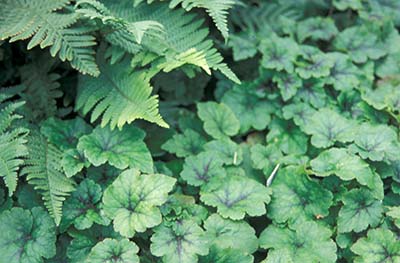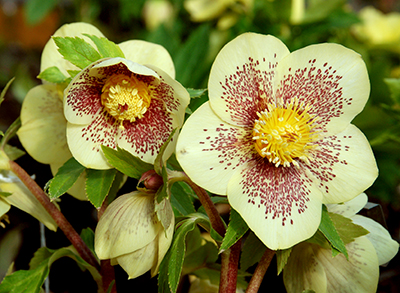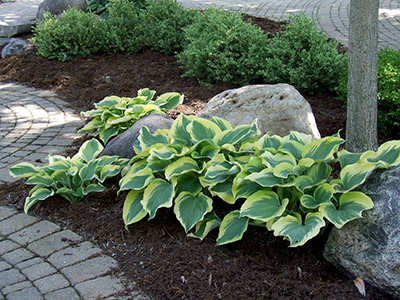Gardening in shade: Choose from a “smart” plant palette
Know the growing requirements of shade-loving plants and the surrounding site before you buy.

Choosing smart plants for your shady garden begins by doing a little research coupled with an analysis of the site. Dazzling displays of flowers and bling foliage is often the first thing we think of when selecting plants. It may surprise you that when choosing plants for under a tree canopy, the smartest thing to think about is its root system.
Shade gardens most often are placed in a wooded setting where ornamental plants are subject to varying degrees of moisture, but also root competition. The tree in your yard did not get as large as it is now without competing against other plants. Deeply rooted oaks can accommodate quite a number of woodland garden plants planted below, but with shallow fibrous roots, maples are notorious nutrient and water “hogs.”
Addressing the rooting habits of the woody plants surrounding your garden and matching it to the rooting habits of the ornamental plants you wish to plant will require a bit of investigation. For example, a woodland plant known as sweet woodruff has a root system that only explores the soil about an inch deep. These plants can easily adapt to a setting where a surface-rooted tree is competing for the space.
Shady companions
Ferns are a wonderful addition to a shade garden. Their dense, fibrous roots will co-mingle with most tree roots and still be able to thrive. Take cues from nature when it comes to choosing ferns. Look around in the woodland areas where you reside to see what plants naturally adapt to the growing conditions of your soil and site. Many ferns prefer a damp woodland environment, but some will also tolerate a drier site.
The delicate and graceful maidenhair fern (Adiantum) will tolerate the densest of shade, but it prefers more moisture than ‘Autumn Brilliance’ wood fern (Dryopteris). With hues of burgundy and jade, the Japanese painted fern (Athyrium) can certainly light up a dark landscape and when the garden gets dry, this fern just goes dormant. Late-summer rains bring it back to life, making it a very adaptable plant.

Tiarella (foam flowers) and ferns make a great shade combination. Photo credit: Rebecca Finneran, MSU Extension
Another great plant group for dry shade is the foam flower or Tiarella. This group sports a dazzling, frothy display of blooms in early spring followed by interesting foliage that can be multi-colored. Tiarella ‘Jade Peacock’ has a tidy, clumping habit comprised of jade green leaves featuring deep purple centers. Other foamflowers such as Tiarella ‘Sugar and Spice’ and Tiarella ‘Spring Symphony’ have the added benefit of being lightly scented.
Tropical texture
Hellebores perform well in a shade garden that receives dappled or filtered bright light. These too will adapt to drier conditions, but they prefer moist organic soil. Coarse, dark green leaves are almost deer-proof and hellebores rock when it comes to the early spring display. Nodding or upright blooms can be deep burgundy, pink, white or yellow. If timing is everything, then these plants are perfect for cheering up a gardener with the first blooms of spring.

‘Golden Sunrise’ hellebore has upward facing, yellow blooms sure to cheer up a shady location. Photo credit: Walter’s Gardens
If you are seeking tropical-looking drama queens for your shady garden, look no further than the humble Hosta. International breeding programs in Hosta continue bringing out new colors, shapes and sizes for eager gardeners. Even the smallest hosta can draw ample attention in a garden. ‘Maui Buttercups’ shows off brilliant gold color through cupped and puckered leaves all summer while only reaching 10 inches high. Out of space in the garden? Miniature hostas such as ‘Mighty Mouse’ and ‘Mini Skirt’ are also making the scene.
The bold texture of hostas brings interest to a shade garden. Photo credit: Rebecca Finneran, MSU Extension
A Michigan native, wild Ginger (Asarum) also provides bold texture in a shaded site. This moisture lover has plate-sized, round, green leaves that form a colony in a dense mass. A low maintenance plant, it is great for erosion control in a shady, moist site too. While the flowers are not seen by us, a quick investigation right at soil level reveals a bloom resembling a little, brown “jug” that will entice a ground beetle into a pollination service. European Gingers are also bold textured, but have shiny leaves that are very striking.
If you are looking at reducing turf in a shady area, the “Shady lawn alternatives” tip sheet will help you sort out fact from fiction.
The Kent County MSU Extension Grand Ideas Garden will host their annual plant sale featuring plants that solve problems on June 5-6 to support garden education in west Michigan. Join the expert team of Michigan State University Extension Master Gardeners who will help you navigate through the choices Friday, June 5 from 5-8 p.m. and again Saturday, June 6 from 9 a.m. to 1 p.m.
For more information on plants that are known to tolerate garden conditions that many of us struggle with in our home landscape, see the following articles from this series:



 Print
Print Email
Email



